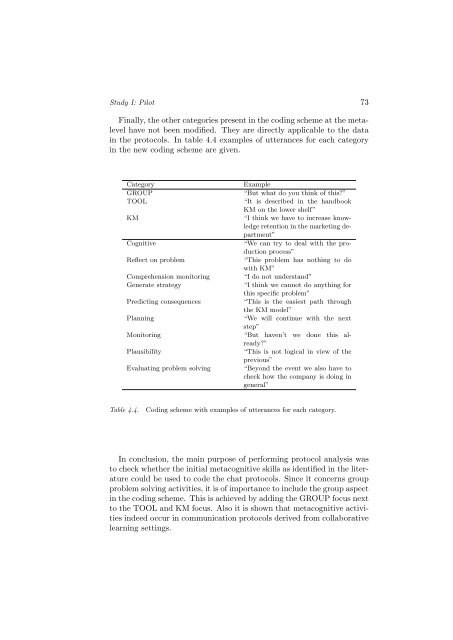The role of metacognitive skills in learning to solve problems
The role of metacognitive skills in learning to solve problems
The role of metacognitive skills in learning to solve problems
Create successful ePaper yourself
Turn your PDF publications into a flip-book with our unique Google optimized e-Paper software.
Study I: Pilot 73<br />
F<strong>in</strong>ally, the other categories present <strong>in</strong> the cod<strong>in</strong>g scheme at the metalevel<br />
have not been modified. <strong>The</strong>y are directly applicable <strong>to</strong> the data<br />
<strong>in</strong> the pro<strong>to</strong>cols. In table 4.4 examples <strong>of</strong> utterances for each category<br />
<strong>in</strong> the new cod<strong>in</strong>g scheme are given.<br />
Category<br />
Example<br />
GROUP<br />
“But what do you th<strong>in</strong>k <strong>of</strong> this?”<br />
TOOL<br />
“It is described <strong>in</strong> the handbook<br />
KM on the lower shelf”<br />
KM<br />
“I th<strong>in</strong>k we have <strong>to</strong> <strong>in</strong>crease knowledge<br />
retention <strong>in</strong> the market<strong>in</strong>g department”<br />
Cognitive<br />
“We can try <strong>to</strong> deal with the production<br />
process”<br />
Reflect on problem<br />
“This problem has noth<strong>in</strong>g <strong>to</strong> do<br />
with KM”<br />
Comprehension moni<strong>to</strong>r<strong>in</strong>g “I do not understand”<br />
Generate strategy<br />
“I th<strong>in</strong>k we cannot do anyth<strong>in</strong>g for<br />
this specific problem”<br />
Predict<strong>in</strong>g consequences<br />
“This is the easiest path through<br />
the KM model”<br />
Plann<strong>in</strong>g<br />
“We will cont<strong>in</strong>ue with the next<br />
step”<br />
Moni<strong>to</strong>r<strong>in</strong>g “But haven’t we done this already?”<br />
Plausibility<br />
“This is not logical <strong>in</strong> view <strong>of</strong> the<br />
previous”<br />
Evaluat<strong>in</strong>g problem solv<strong>in</strong>g “Beyond the event we also have <strong>to</strong><br />
check how the company is do<strong>in</strong>g <strong>in</strong><br />
general”<br />
Table 4.4.<br />
Cod<strong>in</strong>g scheme with examples <strong>of</strong> utterances for each category.<br />
In conclusion, the ma<strong>in</strong> purpose <strong>of</strong> perform<strong>in</strong>g pro<strong>to</strong>col analysis was<br />
<strong>to</strong> check whether the <strong>in</strong>itial <strong>metacognitive</strong> <strong>skills</strong> as identified <strong>in</strong> the literature<br />
could be used <strong>to</strong> code the chat pro<strong>to</strong>cols. S<strong>in</strong>ce it concerns group<br />
problem solv<strong>in</strong>g activities, it is <strong>of</strong> importance <strong>to</strong> <strong>in</strong>clude the group aspect<br />
<strong>in</strong> the cod<strong>in</strong>g scheme. This is achieved by add<strong>in</strong>g the GROUP focus next<br />
<strong>to</strong> the TOOL and KM focus. Also it is shown that <strong>metacognitive</strong> activities<br />
<strong>in</strong>deed occur <strong>in</strong> communication pro<strong>to</strong>cols derived from collaborative<br />
learn<strong>in</strong>g sett<strong>in</strong>gs.
















